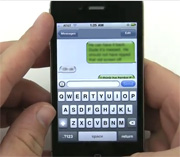
THURSDAY, June 19, 2014 (HealthDay News) — While explicit “sexting” doesn’t appear common among American teenagers, a small new study suggests girls may face a double standard: Boys might consider them promiscuous if they send nude photos but prudes if they don’t.
The findings, based on interviews with a few dozen children, some as young as 12, don’t necessarily represent how kids think overall. And regardless of the study results, researchers in general disagree over whether sexting is a significant problem for teens in the United States.
Still, the study authors say the teens’ comments reveal a potentially disturbing gender trend, even though girls were no more likely than boys to sext.
“The girls who sexted were characterized as slutty, while the girls who didn’t were characterized as prudes. But the boys didn’t face any penalty. It was a very one-sided equation,” said co-author Julia Lippman, a postdoctoral research fellow in psychology at the University of Michigan.
Sexting, a combination of “sex” and “texting,” refers to sexual messages, video or photos sent via a cellphone or computer. People of all ages send such messages to each other, but there is concern about the possible harms particularly from adolescent sexting. One risk is that the intimate images from sexual messages may be redistributed among schoolmates or across the Internet.
The number of teens and younger kids who send sexually explicit photos or videos of themselves is not known. A 2011 survey by the University of New Hampshire found that just 1 percent of American kids aged 10 to 17 said they’d texted images revealing their private parts. But a later University of Utah survey said almost 20 percent of teens aged 14 to 18 had sent sexually explicit photos of themselves.
In the new study, researchers surveyed 51 kids aged 12 to 18 from the Atlanta, New York City and Denver urban areas. About half of them were girls.
Of the 43 kids who responded to the open-ended questionnaire, nine said they’d sent sexts of themselves. Nearly half of survey respondents — mostly males — said they’d received sexts, the researchers reported.
The kids provided comments about sexts and whether such messages indicate sexual interest. One girl wrote, “If a guy wants to hook up with you, he’ll send pictures of his private parts or a naked picture of him.” A boy wrote that “I know I can get it from” girls who send him sexts.
Some said that sexts were “no big deal,” while others judged those who sexted — or didn’t.
“This is common only for girls with ‘slut’ reputations,” wrote an 18-year-old male.
Another criticized girls for sexting but added, “I’m not going to stop it.”
But those who don’t sext were judged, too, with boys declaring that those girls are “stuck up,” “goody” girls or prudes.
“This is the same kind of double standard that we’ve seen in traditional contexts,” said study co-author Scott Campbell, an associate professor of Communication Studies at the University of Michigan.
David Finkelhor, director of the University of New Hampshire’s Crimes against Children Research Center and co-author of the 2011 study, said the study doesn’t break much new ground.
In the big picture, he said, “sexting is really a small part of the teen sexual decision-making problem. The big elements are decision-making around consent and assault, drinking, intercourse, and contraceptive usage.”
What can parents do? Study co-author Lippman suggests that parents teach their kids about resisting peer pressure instead of focusing on the risks.
“Teens are not always in a place where they can think about long-term consequences,” she said.
The study is published online in the June edition of the Journal of Children and Media.
More information
For more about teen dating and sexual feelings, visit the U.S. Department of Health and Human Services.
Copyright © 2025 HealthDay. All rights reserved.

